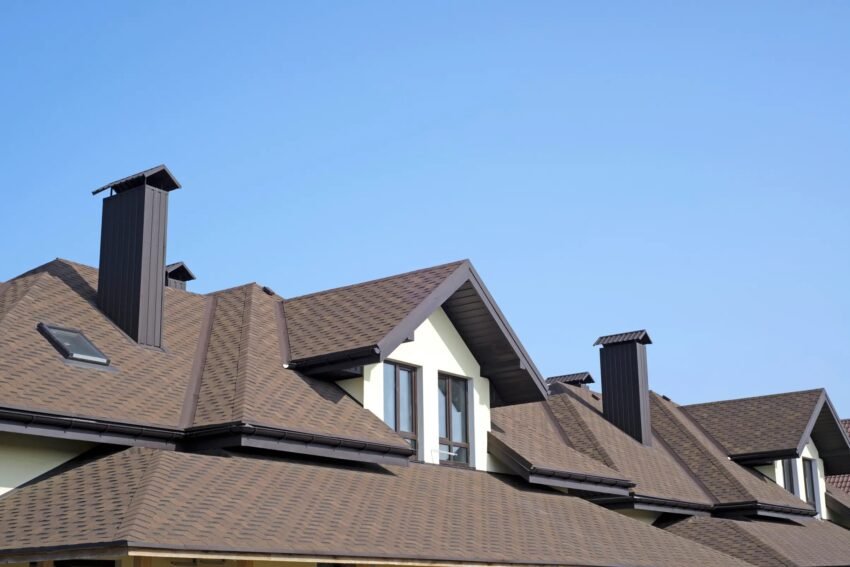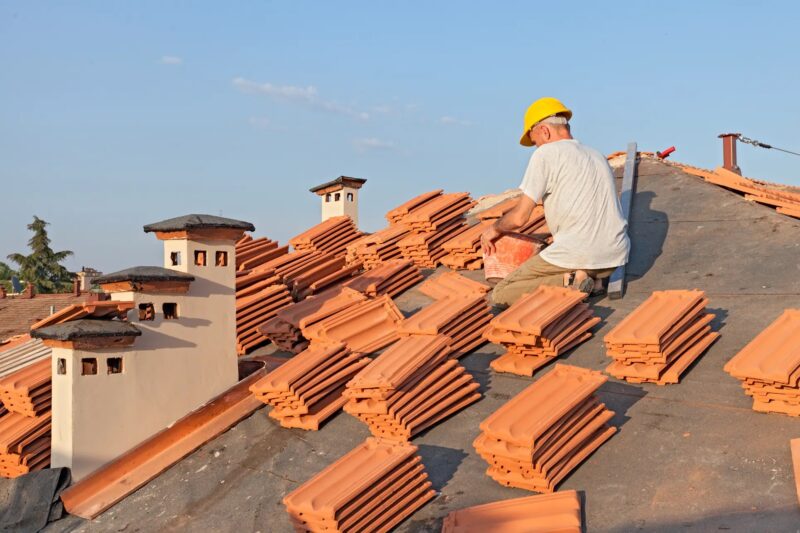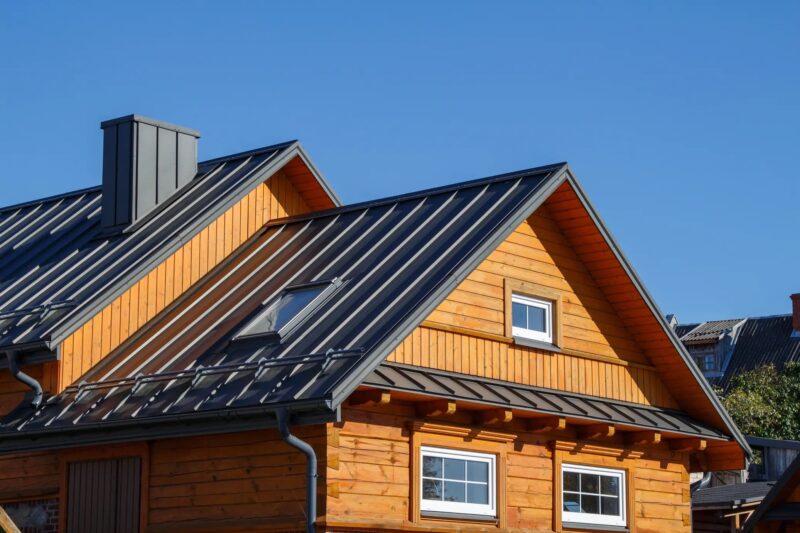
Roof repair is part of regular home maintenance, and even though it’s expensive, it’s just part of owning a home. The average roof replacement cost in the USA is about $10,000, typically from $5,500 to $20,000. For a large home with an expensive roof, the costs can go as high as $80,000. We’re going over all of the factors that go into roof replacement, including costs, material comparisons, and money-saving tips.
When is a Roof Replacement Necessary?
How can you tell when you need a new roof? Replacing a roof is an expensive endeavor, but it’s one that you can’t avoid forever. Eventually, all homes will need their roof replaced.
The average lifespan of a roof is between 25 and 50 years, depending on the quality of the materials and installation. Even though it’s one of the most expensive home improvement projects, it’s one that takes top priority because it’s your home’s main defense against the elements.
Identifying Wear and Tear
Sometimes, roofs simply outlive their lifespan, which can cause them to be more susceptible to damage. Over time, normal wear and tear can lead to shingle damage, leaks and water damage, sagging areas, and more. Learn how to identify wear and tear to determine if a new roof is necessary.
Shingle Damage
Missing or cracked shingles are one of the easiest ways to tell you need a new roof. Other signs of shingle damage include cupping or clawing, where the edges curl up or become warped.
Asphalt shingles have a top layer of crushed stone granules, and when they get old, you’ll start to find pieces of them in your gutters.
Leaks and Water Damage
Leaks and water damage inside your home or attic are signs that your roof is failing and needs to be replaced.
Evaluating Structural Integrity
Over time, the structural integrity of your roof will start to decline. Roofing materials are heavy, and combined with issues like heavy snow loads and aging, your roof can become weakened.
Sagging Areas
Old age, heavy snow loads, or improper installation can cause your roof to sag. If you notice any sagging, it’s important to address it immediately, as it can eventually lead to further damage and potential collapse.
Rot and Mold Growth
Moss or algae may also grow on your old shingles, which is another sign it’s time for a new roof. You should conduct a visual inspection and look for signs of rotting wood, especially on the eaves of your roof.
The Benefits of Opting for Roof Replacement

Replacing your roof will set your mind at ease, but there are other benefits you should consider when deciding when to replace your roof.
Enhancing Home Value
A new roof increases the value of your home, enhances its curb appeal, and improves the structural integrity of your home.
Aesthetic Upgrade
If your home needs a new roof, it’s likely that there are visible signs of damage that are detracting from your home’s curb appeal.
When you replace your roof, it will upgrade the aesthetic appeal of your house. Modern roofing materials come in a variety of colors and textures, so you can even upgrade to a completely new color theme if you want.
Structural Improvement
Many roofs that need to be replaced are sagging or have rotten or damaged wood. Replacing your roof will fix these issues.
Ensuring Safety and Comfort
Roofs are an integral part of your house, and they are crucial for ensuring the safety and comfort of your home.
Weather Protection
Your roof protects the rest of your home from the elements. If your roof leaks, a new roof will provide a secure barrier against snow, rain, and wind and prevent further damage and deterioration to your building.
Energy Efficiency
A new roof can increase the energy efficiency of your home. By choosing lighter or darker shingles, you can impact the energy needs of your home. Many people also choose to install a radiant heat barrier during roof replacement.
Factors that Determine Roof Replacement Costs

Material and labor are the most significant factors influencing roof replacement costs. Learn more about various roof types and labor expenses.
Roof Type & Material Costs
There are many types of roofing materials. Asphalt shingles are the most common type of roof material used in the United States because they are cost-effective and can be used in a wide range of conditions.
Shingle Types and Prices
You should also consider replacement costs when determining the best roof material type. Here are the average lifespans and costs of various roofing materials:
| Type of roof material | Average cost per square foot | Average lifespan |
| Asphalt shingles | $4 to $8 | 15 to 30 years |
| Composite shingles | $7 to $13 | 12 to 20 years |
| Cedar shingles | $6 to $18 | 20 to 25 years |
| Metal shingles | $10 to $35 | 50 to 75 years |
| Slate shingles | $12 to $22 | 125 to 200 years |
Underlayment and Other Materials
No matter what type of roofing material you choose, you also need an underlayment. There are three types of roof underlayment to choose from. The average cost to replace the roof underlayment is $800 to $1,200.
| Underlayment type | Materials cost per square foot | Description |
| Felt | $0.05 to $0.50 | Economical, comes in 15 or 30-lb weights |
| Synthetic | $0.17 to $0.55 | Asphalt-saturated basemat, water resistant and won’t tear easily |
| Rubber | $0.55 to $0.65 | Self-adhering underlayment, does not require fasteners |
Labor Expenses
Approximately 60% of the cost of roof replacement is labor.
Contractor Fees
Roofing contractors who specialize in roof replacements usually charge about $2 to $7 per square foot for labor, which equates to $40 to $60 per hour.
Contractor fees are higher when the job takes longer, as with steep-pitched roofs, remote locations, or hard-to-reach roofs.
Permits and Inspection Costs
Permit costs for roof replacements vary depending on where you live, but they are typically between $150 and $500. Some municipalities don’t require re-roofing permits, and others don’t require them if the roof is under a certain size.
Third-party inspections may be required in some cases. When not included in your permit, they typically cost about $120 to $350.
Additional Costs and Considerations in Roof Replacement

Here are some other costs and factors to consider when you’re replacing your roof.
Incidentals and Surprise Costs
How can you avoid hidden costs during roof replacement? It may be impossible because there is always the possibility of unforeseen damage.
Here are some common issues people run into during roof replacement:
- Pests and mold
- Rotten plywood sheathing
- Water traps caused by poor roof design
You may run into problems protecting your landscape during a roof replacement. It’s a good idea to protect shrubs with tarps and mow your lawn short to make cleanup easier.
Upgrades and Additions
It’s also common to make upgrades during roof replacement. Many people choose to add skylights, upgrade flashing materials, or install gutter systems during roof replacement.
Timing and Seasonality
Most roof replacements are scheduled during the summer, although fall is considered the best time to replace roofs.
Off-Peak Season Pricing
Winter is the cheapest time of year to replace a roof because you can often take advantage of off-peak seasonal pricing. Scheduling during the slow season for roofing isn’t without risks, however. There’s a chance a major snowfall could impact your project’s timeline.
Emergency Replacement Premiums
The average cost of an emergency roof repair is about $750, depending on the season and where you live. The good news for homeowners is that most emergency roof repairs are covered by their insurance policy, while roof replacement generally is not.
Roof Replacement Estimates by Size

The size of your roof will determine the overall cost of a new roof. Take a look at these roof replacement estimates by size.
Small to Medium Roofs
Small roofs require less material and don’t take as long to replace, so the overall cost is lower.
Material Quantity
The easiest way to estimate the size of your home’s roof is to multiply the square footage of your home by 1.5. This makes it easy to calculate the material quantity you need for your roof.
The cost of replacing a roof is $4 to $40 per square foot, with an average cost of $7.
| Home size square feet | Roof size estimate | Average cost of a new roof |
| 1,000 sf | 1,500 | $7,000 |
| 1,500 sf | 2,250 | $10,500 |
| 2,000 sf | 3,000 | $21,000 |
Large Roofs
Roofs on large houses are more challenging, and many of them have steep pitches, requiring the use of specialized equipment like aerial lifts. Due to the sheer size of a roof, the length of the project will increase labor costs.
Most roof projects under 3,000 square feet can be finished in one day, but complex roofs may require up to three weeks.
DIY vs. Professional Roof Replacement Costs

Can you DIY roof replacement? Replacing a roof isn’t as simple as it looks, and it’s definitely a job for an advanced DIYer.
Venturing the DIY Path
If the roof on your home is a simple style and you’re determined to venture down the DIY path to roof replacement, you could be successful at replacing your own roof.
It’s important to understand the skill level required and pay attention to the safety risks. You’ll need to be comfortable with ladders and heights, and it’s always a good idea to have another person to help you.
One of the benefits of DIYing roof replacement is that you can shop around for good deals on roof materials, and you could save up to 75% compared to having your roof professionally replaced. On the downside, DIY roof replacement could result in serious errors that eventually damage your home.
Engaging Professional Services
With professional services, you get guaranteed expertise, and the job will often be finished in one or two days, minimizing the impact on your home and lifestyle.
Professional roofing contractors have the necessary tools, equipment, and know-how to do quality work, giving you peace of mind. Also, some products may be covered under warranty if you do the work yourself.
How to Make Roof Replacement More Affordable:
Follow these money-saving tips to make roof replacement more affordable.
Longevity vs. Initial Cost
Inexpensive roofing materials will usually have to be replaced in 10 to 15 years, which doesn’t save you money in the long run. When opting for cost-effective materials, it’s important to consider the long-term roofing replacement costs.
DIY Some of the Work
When you ask for quotes from roofing contractors, be sure to ask about how you can save by doing part of the work yourself. Even if you don’t feel comfortable replacing your roof, you may be able to save money on roof replacement by tearing off the old roof and repairing damages.
Seasonal Offers
Many roofing companies will offer seasonal rates for roof replacements during the winter. You may also be able to take advantage of retail specials on roofing materials during the off-season.
Frequently Asked Questions About Roof Replacement Costs
Can insurance cover roof replacement costs?
Most home insurance policies don’t cover roof replacement unless it results from a catastrophic event, an act of nature, or a sudden accident. Regular wear and tear and roof deterioration from age are not typically covered by insurance.
How can I financially plan for an unexpected roof replacement?
If you like to plan ahead, it’s a great idea to set aside 10% of your home’s value every year to cover maintenance costs like roof replacements.
Does roof replacement cost vary significantly with material choice?
Roof replacement costs vary considerably depending on the type of roofing material you choose. However, inexpensive options like composite shingles aren’t long-lasting materials, and it’s important to calculate the replacement cost when you’re comparing prices.
Are there financing options available for roof replacement?
There are many ways to finance a roof project. Many banks have a special category of roof loans just for that purpose. You could also take out a standard home equity loan or refinance your home to pay for roof replacement.
Can partial roof replacement be a cost-effective alternative?
Roofing experts don’t recommend partial roof replacement because it’s challenging to join new and old roofs together so they don’t leak. It can also be challenging to match materials, which can impact the aesthetics of your roof.






